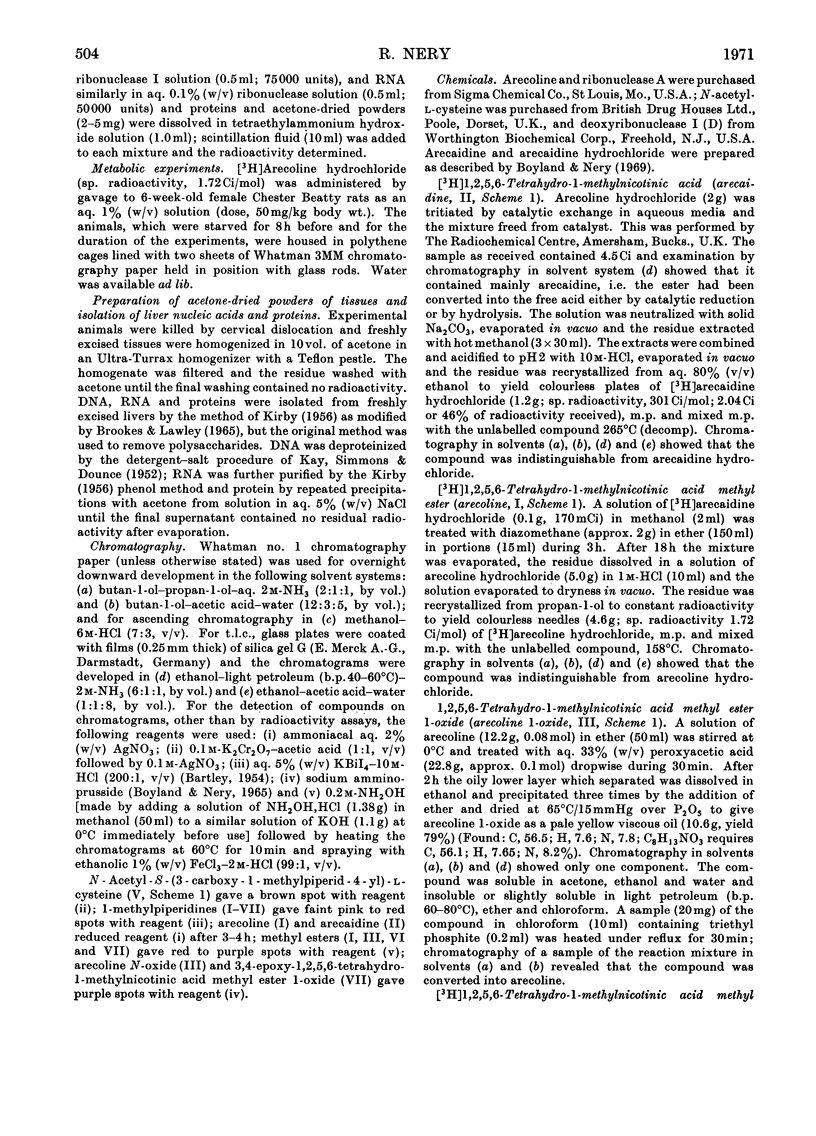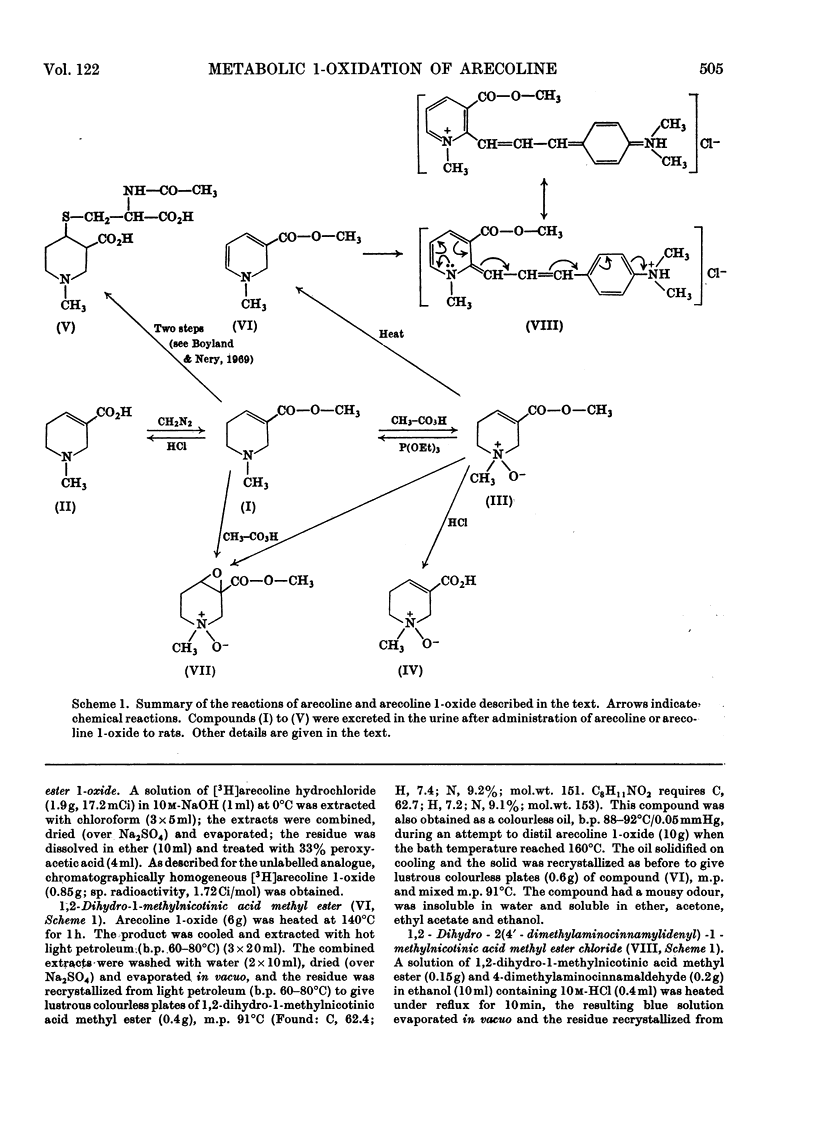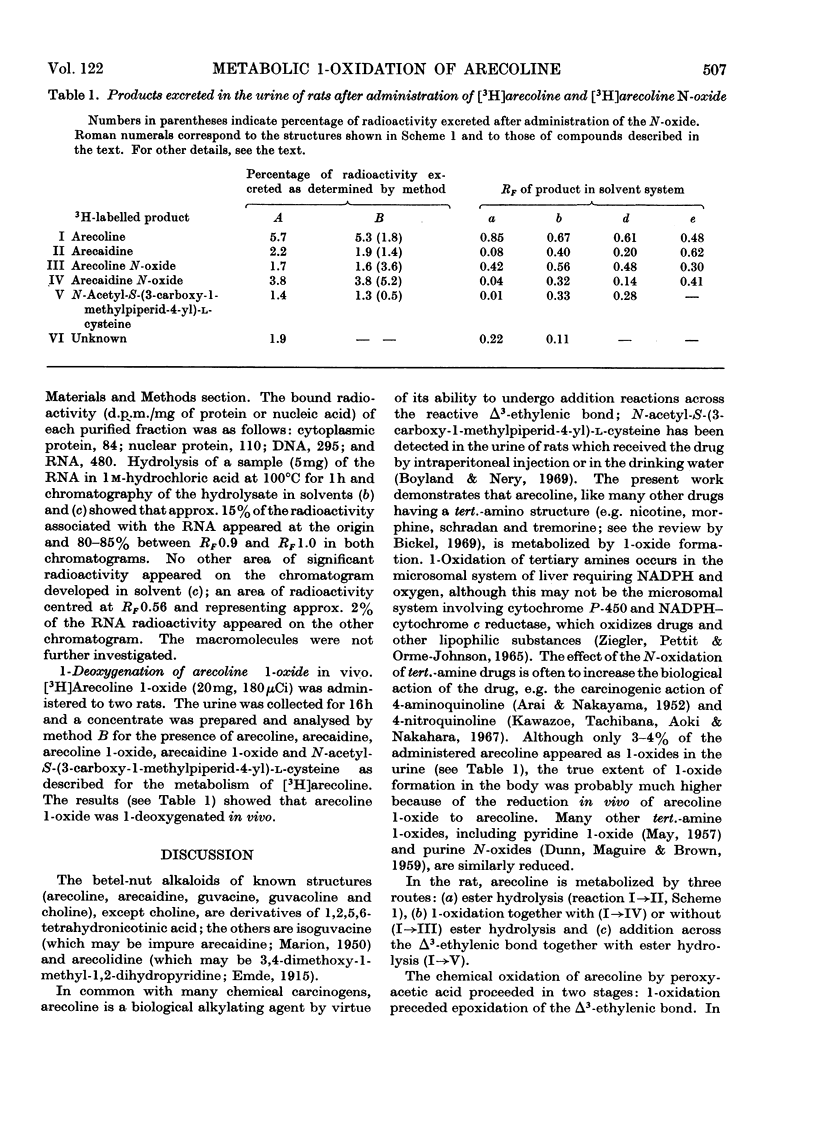Abstract
1. Tritiation of arecoline hydrochloride by catalytic exchange in aqueous media (done by The Radiochemical Centre) gave arecaidine hydrochloride of high specific radioactivity; this on treatment with diazomethane gave [3H]arecoline, which was oxidized with peroxyacetic acid to [3H]arecoline 1-oxide. 2. Arecoline 1-oxide gave arecaidine 1-oxide on acid hydrolysis and 1,2-dihydro-1-methylnicotinic acid methyl ester on thermal decomposition. 3. [3H]Arecoline hydrochloride was metabolized in the rat into the 3H-labelled derivatives of arecoline 1-oxide, arecaidine 1-oxide, arecaidine, N-acetyl-S-(3-carboxy-1-methylpiperid-4-yl)-l-cysteine and an unidentified metabolite; some unchanged arecoline was also excreted. [3H]Arecoline 1-oxide gave the same metabolities, but in different amounts. 4. The possible relevance of these findings to betel-nut carcinogenesis is discussed.
Full text
PDF





Selected References
These references are in PubMed. This may not be the complete list of references from this article.
- BARTLEY W. Metabolism of thiamine phosphates in washed suspensions of kidney particles. Biochem J. 1954 Mar;56(3):379–387. doi: 10.1042/bj0560379. [DOI] [PMC free article] [PubMed] [Google Scholar]
- BOYLAND E., NERY R. THE MATABOLISM OF URETHANE AND RELATED COMPOUNDS. Biochem J. 1965 Jan;94:198–208. doi: 10.1042/bj0940198. [DOI] [PMC free article] [PubMed] [Google Scholar]
- Bickel M. H. The pharmacology and biochemistry of N-oxides. Pharmacol Rev. 1969 Dec;21(4):325–355. [PubMed] [Google Scholar]
- Boyland E., Nery R. Mercapturic acid formation during the metabolism of arecoline and arecaidine in the rat. Biochem J. 1969 Jun;113(1):123–130. doi: 10.1042/bj1130123. [DOI] [PMC free article] [PubMed] [Google Scholar]
- DUNN D., MAGUIRE M. H., BROWN G. B. Purine N-oxides. VI. The metabolism of adenine 1-N-oxide. J Biol Chem. 1959 Mar;234(3):620–624. [PubMed] [Google Scholar]
- KIRBY K. S. A new method for the isolation of ribonucleic acids from mammalian tissues. Biochem J. 1956 Nov;64(3):405–408. doi: 10.1042/bj0640405. [DOI] [PMC free article] [PubMed] [Google Scholar]
- Kawazoe Y., Tachibana M., Aoki K., Nakahara W. The structure-carcinogenicity relationship among derivatives of 4-nitro and 4-hydroxylaminoquinoline 1-oxides. Biochem Pharmacol. 1967 Apr;16(4):631–636. doi: 10.1016/0006-2952(67)90074-3. [DOI] [PubMed] [Google Scholar]
- MAY A. Bioreduction of pyridine N-oxide. Enzymologia. 1957 Jan 30;18(2):142–144. [PubMed] [Google Scholar]
- MUIR C. S., KIRK R. Betel, tobacco, and cancer of the mouth. Br J Cancer. 1960 Dec;14:597–608. doi: 10.1038/bjc.1960.65. [DOI] [PMC free article] [PubMed] [Google Scholar]
- Nieschulz O., Schmersahl P. Zur Pharmakologie der Wirkstoffe des Betels. 2. Umnoandlung des Arecolin in Arecaidin. Arzneimittelforschung. 1968 Feb;18(2):222–225. [PubMed] [Google Scholar]
- PAYMASTER J. C. Some observations on oral and pharyngeal carcinomas in the State of Bombay. Cancer. 1962 May-Jun;15:578–583. doi: 10.1002/1097-0142(196205/06)15:3<578::aid-cncr2820150318>3.0.co;2-3. [DOI] [PubMed] [Google Scholar]
- Pindborg J. J., Poulsen H. E., Zachariah J. Oral epithelial changes in thirty Indians with oral cancer and submucous fibrosis. Cancer. 1967 Jul;20(7):1141–1146. doi: 10.1002/1097-0142(196707)20:7<1141::aid-cncr2820200717>3.0.co;2-4. [DOI] [PubMed] [Google Scholar]
- Schonland M., Bradshaw E. Upper alimentary tract cancer in Natal Indians with special reference to the betel-chewing habit. Br J Cancer. 1969 Dec;23(4):670–682. doi: 10.1038/bjc.1969.83. [DOI] [PMC free article] [PubMed] [Google Scholar]
- Tennekoon G. E., Bartlett G. C. Effect of betel chewing on the oral mucosa. Br J Cancer. 1969 Mar;23(1):39–43. doi: 10.1038/bjc.1969.6. [DOI] [PMC free article] [PubMed] [Google Scholar]


